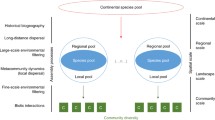Abstract
We examine the spatial pattern of woody species diversity at different scales, in two sites of Mt. Holomontas in northern Greece, which falls within the transitional zone between temperate forests and Mediterranean-type ecosystems. We investigate how diversity is distributed in space and whether the perceived pattern changes with the scale of observation. We use two different metrics of diversity: species richness and species turnover. Our main finding is that the spatial pattern of diversity changes with the scale of observation or analysis. For a given scale, the pattern of species richness (alpha diversity) is negatively correlated with the pattern of species turnover (beta diversity). Species-rich areas have more species in common with their neighbors than species-poor areas. The between-scale disparity of the spatial pattern of diversity may be a general feature of ecological systems. For this to be validated, studies with different groups of species in different biomes and in different biogeographical areas are required; our study contributes to this direction providing evidence that this holds true for woody species in Mediterranean communities. Finally, we discuss how these findings might affect important issues in theoretical and applied ecology, such as identifying the environmental factors driving biodiversity.



Similar content being viewed by others
References
Blackburn TM, Gaston KJ (1996) Spatial patterns in the species richness of birds in the new world. Ecography 19:369–376
Clifford P, Richardson S, Hemon D (1989) Assessing the significance of the correlation between 2 spatial processes. Biometrics 45:123–134
Foody GM (2004) Spatial nonstationarity and scale-dependency in the relationship between species richness and environmental determinants for the sub-Saharan endemic avifauna. Global Ecol Biogeogr 13:315–320
Harrison S, Ross SJ, Lawton JH (1992) Beta-diversity on geographic gradients in Britain. J Anim Ecol 61:151–158
He FL, Legendre P (2002) Species diversity patterns derived from species-area models. Ecology 83:1185–1198
He F, LaFrankie JV, Song B (2002) Scale dependence of tree abundance and richness in a tropical rain forest, Malaysia. Landscape Ecol 17:559–568
Heegaard E (2004) Trends in aquatic macrophyte species turnover in Northern Ireland – which factors determine the spatial distribution of local species turnover? Global Ecol Biogeogr 13:397–408
Hunter JT (2005) Geographic variation in plant species richness patterns within temperate eucalypt woodlands of eastern Australia. Ecography 28:505–514
Hurlbert AH, White EP (2005) Disparity between range map- and survey-based analyses of species richness: patterns, processes and implications. Ecol Lett 8:319–327
Jetz W, Rahbek C (2002) Geographic range size and determinants of avian species richness. Science 297:1548–1551
Jetz W, Rahbek C, Lichstein JW (2005) Local and global approaches to spatial data analysis in ecology. Global Ecol Biogeogr 14:97–98
Kallimanis AS, Ragia V, Sgardelis SP, Pantis JD (2007) Using regression trees to predict alpha diversity based upon geographical and habitat characteristics. Biodivers Conserv (in press)
Kati V, Devilliers P, Dufrene M, Legakis A,Vokou D, Lebrun P (2004a) Hotspots, complementarity or representativeness? Designing optimal small-scale reserves for biodiversity conservation. Biol Conserv 120:471–480
Kati V, Devilliers P, Dufrene M, Legakis A, Vokou D, Lebrun P (2004b) Testing the value of six taxonomic groups as biodiversity indicators at a local scale. Conserv Biol 18:667–675
Koleff P, Gaston KJ (2002) The relationships between local and regional species richness and spatial turnover. Global Ecol Biogeogr 11:363–375
Koleff P, Gaston KJ, Lennon JJ (2003) Measuring beta diversity for presence-absence data. J Anim Ecol 72:367–382
Lennon JJ, Koleff P, Greenwood JJD, Gaston KJ (2001) The geographical structure of British bird distributions: diversity, spatial turnover and scale. J Anim Ecol 70:966–979
Lira-Noriega A, Soberón J, Navarro-Sigüenza AG, Nakazawa Y, Townsend Peterson A (2007) Scale dependency of diversity components estimated from primary biodiversity data and distribution maps. Divers Distrib 13:185–195
Loreau M (2000) Are communities saturated? On the relationship between alpha, beta and gamma diversity. Ecol Lett 3:73–76
Moreno CE, Halffter G (2000) Assessing the completeness of bat biodiversity inventories using species accumulation curves. J Appl Ecol 37:149–158
Økland RH, Bratli H, Dramstad WE, Edvardsen A, Engan G, Fjellstad W, Heegaard E, Pedersen O, Solstad H (2006) Scale-dependent importance of environment, land use and landscape structure for species richness and composition of SE Norwegian modern agricultural landscapes. Landscape Ecol 21:969–987
Okuda T, Noda T, Yamamoto T, Ito N, Nakaoka M (2004) Latitudinal gradient of species diversity: multi-scale variability in rocky intertidal sessile assemblages along the Northwestern Pacific coast. Popul Ecol 46:159–170
Orme CDL, Davies RG, Burgess M, Eigenbrod F, Pickup N, Olson VA, Webster AJ, Ding TS, Rasmussen PC, Ridgely RS, Stattersfield AJ, Bennett PM, Blackburn TM, Gaston KJ, Owens IPF (2005) Global hotspots of species richness are not congruent with endemism or threat. Nature 436:1016–1019
Palmer MW, White PS (1994) Scale dependence and the species-area relationship. Am Nat 144:717–740
Pärtel M, Zobel M, Liira J, Zobel K (2000) Species richness limitations in productive and oligotrophic plant communities. Oikos 90:191–193
Rahbek C, Graves GR (2001) Multiscale assessment of patterns of avian species richness. Proc Natl Acad Sci USA 98:4534–4539
Shriner SA, Wilson KR, Flather CH (2006) Reserve networks based on richness hotspots and representation vary with scale. Ecol Appl 16:1660–1673
Soininen J, McDonald R, Hillebrand H (2007) The distance decay of similarity in ecological communities. Ecography 30:3–12
Whittaker RM (1960) Vegetation of the Siskiyou mountains, Oregon and California. Ecol Monogr 30:279–338
Zhang Y, Ma K, Anand M, Fu B (2006) Do generalized scaling laws exist for species abundance distribution in mountains? Oikos 115:81–88
Acknowledgments
Prof. S. Kokkini, from the Laboratory of Systematic Botany and Phytogeography, Aristotle University of Thessaloniki, Greece, identified the plant species collected. Research was funded by the General Secretariat for Research and Technology of the Ministry of Development of the Hellenic Republic (grant 97EL-6).
Author information
Authors and Affiliations
Corresponding author
Rights and permissions
About this article
Cite this article
Kallimanis, A.S., Halley, J.M., Vokou, D. et al. The scale of analysis determines the spatial pattern of woody species diversity in the Mediterranean environment . Plant Ecol 196, 143–151 (2008). https://doi.org/10.1007/s11258-007-9341-6
Received:
Accepted:
Published:
Issue Date:
DOI: https://doi.org/10.1007/s11258-007-9341-6




